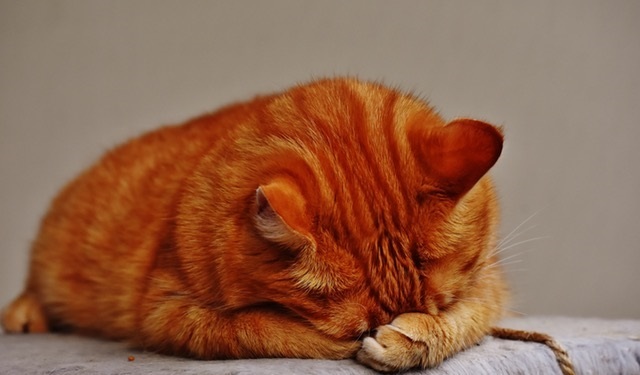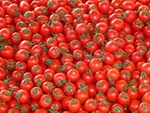
We humans do really enjoy feeding our pets bits and pieces of our own food don’t we? We often consider it a treat for them because it is something we particularly enjoy or it is something new in their diet.
That being said, just because we like it doesn’t necessarily mean it is something they will enjoy. Worse yet, many foods we humans consume can be incredibly toxic to your feline friends.
So let’s take a quick look at what foods are poisonous for cats s so you know what to avoid feeding her. Note that I’ve got a little bit of overlap between this article and my article on house plants.
But since many house plants are not really edible for humans that article isn’t comprehensive. If you’re curious about what plants can make your cat ill please check out my article dedicated to the 31 most common plants poisonous to your cat.
So Which Foods Should I Look Out for?
If you’d prefer to scan pictures and read through the names I’ve outlined a pretty comprehensive list below. These are 15 of the most common foods that can be dangerous to your cat if eaten.
Note the list is in alphabetical order, not in order of severity or danger. Any of the below foods can cause issues for your cat if they eat enough of it.
The quantity that determines “enough” varies by each specific food. Do your best to keep an eye on your kitty and make sure they have healthy food to eat so they aren’t as tempted to go after these items if they just so happen to be lying around the house.
I’ve also included a link from each individual item over to the Poison Pet Helpline website so you can read up on the food in more detail if you’d like.
Note a few of these don’t have specific details at the PPH so I’ve included additional source links at the bottom of the article if you want to dig into it further.
 1. Alcohol
1. Alcohol
Alcohol is pretty darn toxic to cats. Let’s be honest, it isn’t really all that good for humans either. But in cats alcohol can cause a heck of a lot of problems, most commonly vomiting, diarrhea and trouble with coordination.
More serious amounts of alcohol can cause issues with central nervous system depression, difficulty breathing, tremors, coma and even death. Under no circumstances should your pet be given any alcohol.
If you suspect that your pet has ingested alcohol, contact your veterinarian or the ASPCA Animal Poison Control Center immediately.
2. Avocado
Avocado isn’t super toxic to cats, the impact is normally pretty mild. While it doesn’t have much of a chance of causing any serious problems for your feline friend, it can cause rather annoying problems (for both you and the cat) like diarrhea and vomiting.
It would probably be best to avoid avocados, especially if your pet has eaten them before and had a tough time afterward.
 3. Chocolate, Coffee and Caffeine
3. Chocolate, Coffee and Caffeine
These products are all derived from cacao seeds, the fruit of the plant used to make coffee. Cacao seeds contain methylxanthines and when ingested by pets, methylxanthines can cause vomiting and diarrhea, panting, excessive thirst and urination.
While 1-2 laps of any of the above don’t contain enough to cause poisoning in most pets (especially larger pets), the ingestion of moderate amounts could lead to serious issues.
Note that darker chocolate is even more dangerous because it has even more cacao. White chocolate has the lowest level of cacao while baking chocolate contains the highest.
4. Citrus
The stems, leaves, peels, fruit and seeds of citrus plants contain varying amounts of citric acid, essential oils that can cause irritation and even central nervous system depression if ingested in significant enough amounts.
Small doses, such as eating the fruit, are not likely to present problems beyond some indigestion, but large amounts can be pretty problematic.
An additional note, citrus peels can work as a solid deterrent to keep your cat away from houseplants, primarily because they don’t tend to like the strong smell. That being said obviously you have to make sure they aren’t eating them.
5. Fat Trimmings or Extremely Fatty Meals like Gravy
Extremely fatty foods are incredibly ‘rich.’ Similar to when we humans eat foods like that it can cause vomiting & diarrhea. Even more severe is a painful condition called pancreatitis which can result from excessive fat in the diet.
Fat trimmings are also very dangerous if they are raw because they carry the risk of Salmonella or E. coli associated with any other raw food or meat.
6. Liver
You can absolutely feed your cat small amounts of liver, but eating too much liver can cause vitamin A toxicity. Vitamin A toxicity can be pretty darn serious and can affect your cat’s bones through deformed bones, bone growths on the elbows and spine, and even osteoporosis.
Vitamin A toxicity in its most severe cases can even result in death.
 7. Milk and Dairy
7. Milk and Dairy
Because cats do not possess significant amounts of lactase (the enzyme that breaks down lactose in milk), milk and other dairy-based products cause them diarrhea or other digestive upset. Despite the classic picture of a cat lapping milk up from a saucer, this can in fact cause your cat quite a bit of discomfort.
8. Nutmeg
Nutmeg contains a toxin called myristicin that can cause issues within cats. Note that it would take a significantly large amount of nutmeg to cause anything beyond a mild stomach upset.
Dr. Charlotte Flint, DVM indicates that if a very large amount of nutmeg is ingested then “symptoms including hallucinations, disorientation, increased heart rate, high blood pressure, dry mouth, abdominal pain, and possibly seizures could occur. Symptoms can last up to 48 hours.”
9. Onions, Garlic, Chives
These vegetables and herbs can cause gastrointestinal irritation and could lead to red blood cell damage. Most of these were also called out in my house plants or garden article.
I’ve repeated them here because if a large enough amount is consumed it can be really dangerous for a cat. Toxicity is normally diagnosed through history, clinical signs and microscopic confirmation of Heinz bodies.
10. Raw/Undercooked Meat, Eggs and Bones
Raw meat and raw eggs can contain Salmonella, E. coli and a wide variety of other bacteria that can be very dangerous to cats. Raw eggs contain an enzyme called avidin that decreases the absorption of biotin (a B vitamin), which can lead to skin and coat problems.
Feeding your pet bones, especially chicken bones, may seem like a natural and healthy option. It’s even something they might experience in the wild. This is pretty dangerous for your cat at home though.
Your cat could choke on bones, but the most likely thing to happen is that your cat gets a nasty injury if the bone splinters and become lodged in or punctures your pet’s digestive tract.
11. Salt and Salty Snack Foods
Large amounts of salt aren’t terribly good for any species, cats included. Over ingestion of salt can make your cat overly dehydrated, and since cats don’t have a high thirst drive they don’t tend to drink a lot of water to help balance this out.
This can lead to sodium poisoning in in your cat. Signs that your cat may have eaten too many salty foods include vomiting & diarrhea in their most basic form.
12. Seeds & Stems from Apples, Apricots, Cherries, Peaches & Plums
Keep in mind this is pretty specific to the stems and the seeds and is even more dangerous if the fruit is wilting or beginning to rot. The general problem is that the stems and the seeds contain cyanide.
Cyanide is really not too good for pretty much any living creature. Obvious signs of ingestion are dilated pupils, difficulty breathing, panting & shock.
 13. Tomato Leaves and Stems
13. Tomato Leaves and Stems
There’s actually some debate on whether or not tomatoes are dangerous for your cat. The ingredient that is indicated as toxic for you cat is called Solanine.
Research shows that solanine is quite dangerous to cats, but the science that proves solanine is in fact commonly found in tomatoes is not definitive.
While the jury is still out for a final decision, it might pay to avoid tomatoes parts for the time being.
14. Tuna & Raw Fish in General
Your cat shouldn’t be eating tuna regularly due to a couple of concerns. This applies to both tuna cat food and also includes human-grade canned tuna.
Why human grade tuna? First, tuna prepared for humans doesn’t really focus on the feline diet meaning that if you feed it to your cat over a long period of time they could suffer from a nutrient deficiency.
If you’re going with raw tuna instead you should be careful because raw tuna, like all raw fish, contains enzymes that destroy thiamine. Thiamine is important because it helps maintain proper neurological health for your cat.
On top of this, fish in general, tuna in particular, are becoming more and more mercury-contaminated. It is probably a good idea to pass on Tuna unless you know of a very high quality source.
 15. Xylitol
15. Xylitol
Xylitol is a sweetener that’s used in a wide variety or products, particularly sweets like gum and candy. Xylitol can cause insulin release in cats, which can lead to liver failure.
The increase in insulin leads to hypoglycemia (lowered sugar levels). Initial signs of toxicosis include vomiting, lethargy and loss of coordination. Signs can progress to seizures.
Elevated liver enzymes and liver failure can be seen within a few days.
If You’re More of a Video Person
If on the other hand you prefer a video to show you the ropes you can check out this very informative video from Dr. Andrew Jones. Dr. Jones goes through a list of about 15 different foods we humans commonly eat and might offer to our pets and explains the potential issues they might cause your cat.
I think it is important to note up front that feeding your cat these things one time or on and off doesn’t necessarily cause an immediate response or an immediate problem. Many of these foods build up in the system over time and eventually cause damage.
You’ll also note there’s a little bit of a difference between the list here and the list in the video, this is done intentionally as I listed the most important ones I’ve found from all sources above, but wasn’t able to identify a single video that called all of them out.
Wrapping things up:
Hopefully the list and the video have been helpful to you in showing you what foods are poisonous for cats. I hope it will help your cat stays safe and sound in and around your home!
While the list above calls out the most common foods poisonous to cats there are literally hundreds of things that can make your cat sick. I’m not saying this in any way to scare you or try to convince you to keep your cat locked up and all your cupboards padlocked!
I just want you to be able to keep a close eye on the diet of your kitty and do your best not to feed him or her human foods that are dangerous!
For more comprehensive lists please visit the following links:
- Pet Poison Help Line – Here you can search for any type of food and see if it is poisonous to cats (as well as dogs, horses and bunch of other animals).
- The ASPCA Poison Database – Here you can look for any type of food or really anything and see if it is poisonous to cats. There isn’t much of a search capability built in, but you can click into the major categories and do a CTRL-F to find items on the page.
While the biggest problem and most likely cause of your cat getting into this kind of food is from you or a family member directly feeding it to them, it is also possible you’ve got a cat that likes to cause a ruckus and get into shelves and packaging.
If this is the case then you’ll want to explore shelf locks and sealed containers. You can also take a look at this article from Pet-Happy that might help you keep your cat(s) away from places like the dinner table where they are most likely to get their claws into your human food.
If you’re worried your cat has eaten something poisonous then get your cat to a veterinarian as quickly as possible and note whatever they’ve eaten. If it is after hours and you need help immediately then you can try one of the following:
- Contact the ASPCA National Animal Poison Control Center at one of these numbers: 1-888-426-4435 (a $65 dollar charge might apply)
- Call the Pet Poison Help Line at 855-764-7661 (note there is a $59 dollar charge for their help)
Please share any experience you have in keeping your cat from eating human food. Feel free to leave a comment about it below or email me directly at Craig@StuffCatsWant.com. I’ll be happy to update the article to reflect any additional information!
Additional sources: ASPCA, Vets-New, WebMD, PetMD
Please note that StuffCatsWant is providing this information as a service to the public. I am not a veterinarian and nor do I claim to be. Your veterinarian should handle any diagnosis and treatment if your cat has eaten any of the plants above. StuffCatsWant disclaims all warranties and liability related to the veterinary advice and information provided on this site.
StuffCatsWant.com is a participant in the Amazon Services LLC Associates Program, an affiliate advertising program designed to provide a means for sites to earn advertising fees by advertising and linking to Amazon.com.
